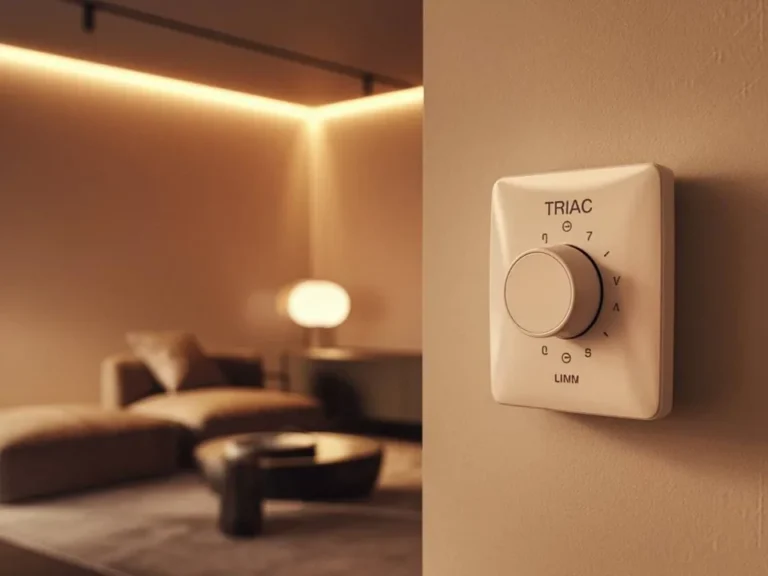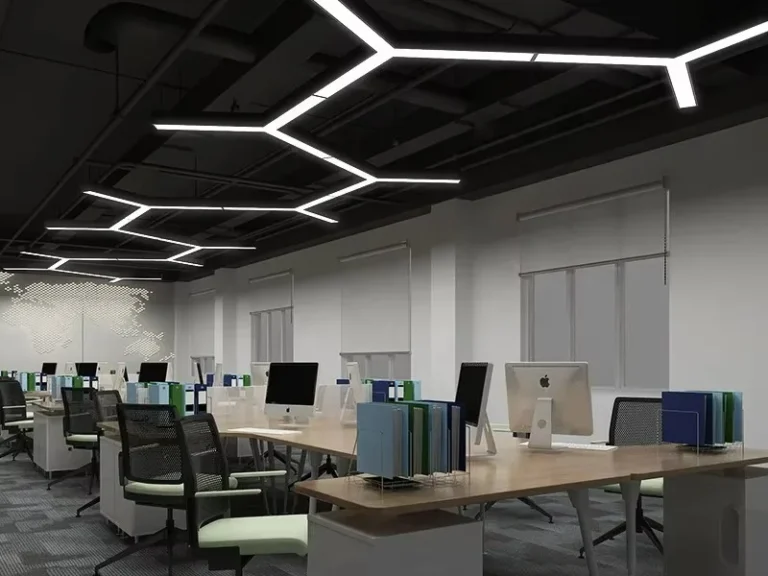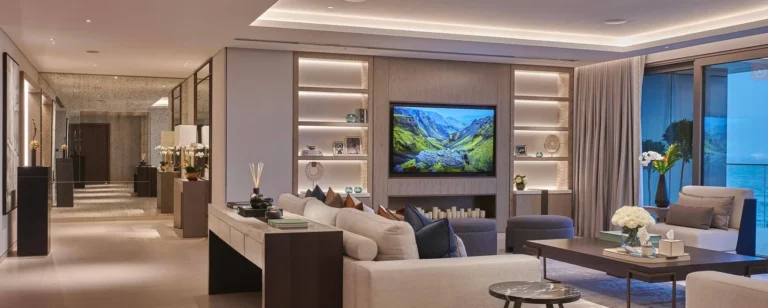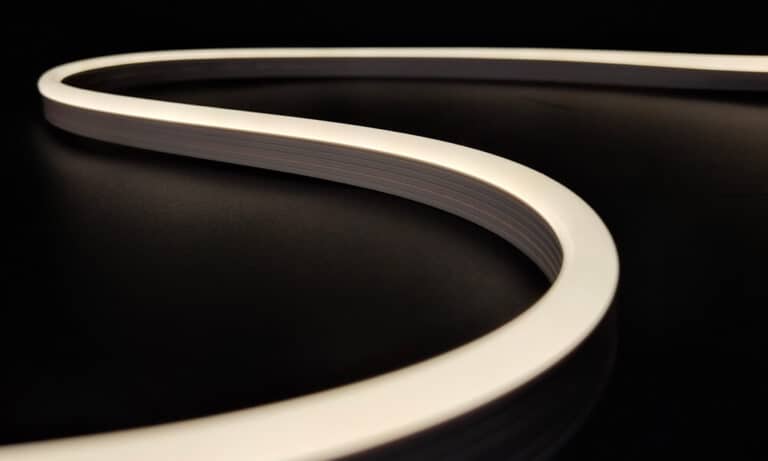Podczas planowania projektu oświetlenia LED, czy to w przypadku witryn sklepowych, fasad budynków, oświetlenia biurowego lub oznakowania, zrozumienie zużycia energii przez światła LED jest kluczowym krokiem. Pomaga nie tylko wybrać odpowiedni zasilacz, aby uniknąć przeciążenia obwodu, ale także wpływa na ogólny budżet energetyczny projektu i długoterminowe koszty operacyjne.
Taśmy LED, dzięki swoim energooszczędnym charakterystykom stopniowo zastępowały tradycyjne metody oświetlenia. Jednak w rzeczywistym użyciu na ich zużycie energii wpływa wiele czynników, takich jak moc na metr (W/m), napięcie wejściowe (np. 12V/24V), gęstość LED (liczba diod LED) i dzienny czas użytkowania. W przypadku projektów oświetlenia komercyjnego i przemysłowego nawet różnica kilku watów na metr może spowodować znaczne różnice w kosztach energii elektrycznej w dłuższej perspektywie.
W tym obszernym przewodniku przedstawimy szczegółową analizę:
- Jak obliczyć zużycie energii i koszty energii elektrycznej pasków świetlnych LED (waty i kWh)
- Czynniki wpływające na faktyczne zużycie energii przez paski świetlne
- Porównanie różnic w zużyciu energii między typowymi typami pasków świetlnych LED
- Jak wybrać energooszczędne paski świetlne LED
- Studia przypadków w świecie rzeczywistym i energooszczędne zalecenia w celu zwiększenia opłacalności projektu
Następnie zaczniemy od podstaw: Jak obliczany jest zużycie energii lamp LED?
Metody obliczeń i wyjaśnienia jednostkowe dla zużycia światła taśmy LED
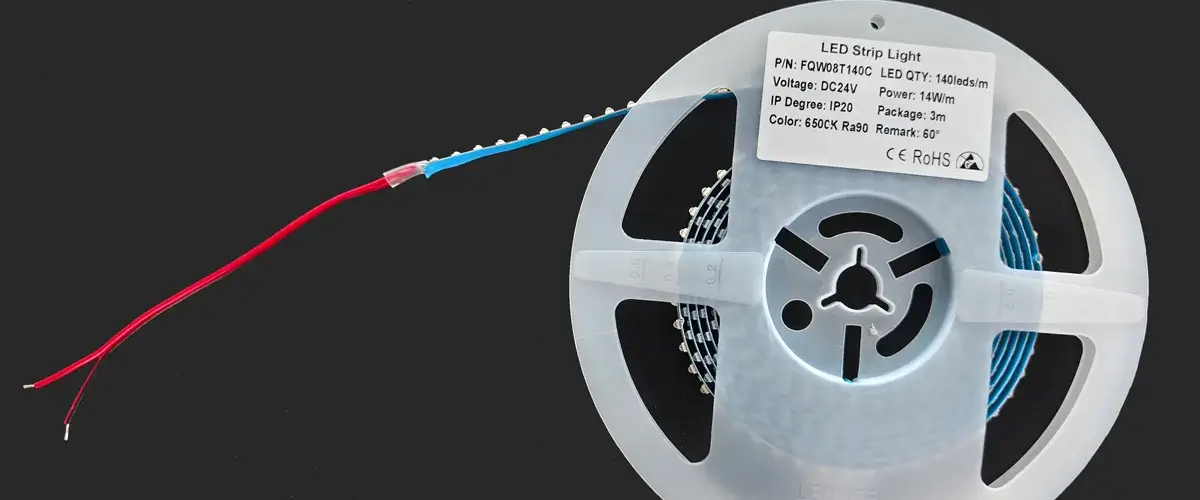
Aby dokładnie zrozumieć zużycie energii przez światła LED, należy najpierw uchwycić kilka podstawowych pojęć i jednostek, które mają kluczowe znaczenie dla wyboru produktów, dystrybucji mocy systemu, a nawet cen i cen. Chcesz dowiedzieć się więcej? Przeczytaj nasz blog: Kompletny przewodnik po taśmach LED.
1. Moc (Wat, W) — podstawowy wskaźnik zużycia energii
Moc pasków świetlnych LED jest zwykle mierzona w „watów na metr (W/m)”, wskazując na pobór mocy na metr paska świetlnego przy napięciu znamionowym.
Na przykład listwa świetlna o mocy znamionowej 14,4 W/m i długości 5 metrów ma moc roboczą:
14,4 × 5 = 72 W
Oznacza to, że pasek świetlny zużywa 72 waty mocy na godzinę podczas pracy.
2. Napięcie (V) — określa konfigurację prądu i okablowania
Wspólne napięcia robocze pasków świetlnych LED obejmują 12 V, 24 V i 48 V. Chociaż napięcie nie wpływa na całkowity pobór mocy, określa prąd o magnitudzie i straty linii:
- Przy tym samym poziomie mocy wyższe napięcie powoduje niższy prąd i niższy spadek napięcia w linii, co czyni go bardziej odpowiednim do okablowania na duże odległości.
Na przykład:
72W @ 12V → prąd = 6A
72W @ 24V → Prąd = 3A
Jest to szczególnie ważne w przypadku komercyjnych zastosowań oświetleniowych wykorzystujących paski świetlne dłuższe niż 10 metrów. Czy powinienem wybrać diody LED 12V czy 24V? Przeczytaj bloga: Taśmy LED 12V vs. 24V: Jak wybrać?
3. Elektryczność CNasysanie (kWh, kilowatogodziny)—A koj Indakator Aflaksowanie Ezmysłowość CWSKAZÓWKI
Aby oszacować rzeczywiste koszty energii elektrycznej, moc musi zostać przeliczona na „kilowatogodzin (kWh)”, powszechnie określaną jako „kWh”. Wzór obliczeń jest następujący:
Zużycie energii elektrycznej (kWh) = moc (W) × Czas użytkowania (godziny) ÷ 1000
Przykład: taśma świetlna LED o łącznej mocy 72 W, używana przez 8 godzin dziennie, działająca przez 30 dni w miesiącu:
Dzienne zużycie energii elektrycznej: 72 × 8 ÷ 1000 = 0,576 kWh
Miesięczne zużycie energii elektrycznej: 0,576 × 30 = 17,28 kWh
Jeśli stawka za energię elektryczną wynosi $0,12 za kWh, miesięczny rachunek za energię elektryczną wyniesie około 17,28 × 0,12 = $2,07.
4. Świetlisty EFucacy (lm/w)—An Iważny Idyktator dla Erzeczowy Energia Ewydajność
Skuteczność świetlna odnosi się do liczby lumenów (strumień światła) na wat mocy, mierzonej w lm/W. W przypadku zastosowań komercyjnych zaleca się dobór pasków świetlnych LED o skuteczności świetlnej ≥ 100 lm/W, co może zapewnić jasność przy jednoczesnym zmniejszeniu zużycia energii.
Rozumiejąc te podstawowe koncepcje, możesz bardziej naukowo zaplanować zużycie energii elektrycznej w projekcie i wybrać naprawdę energooszczędne, opłacalne rozwiązania taśm świetlnych LED. Następnie zagłębimy się w kluczowe czynniki wpływające na zużycie energii w praktycznych zastosowaniach.
Proszę obejrzeć wideo, aby dowiedzieć się, jak obliczyć zużycie energii przez światła taśmowe LED.

Kluczowe czynniki wpływające na zużycie światła taśmy LED
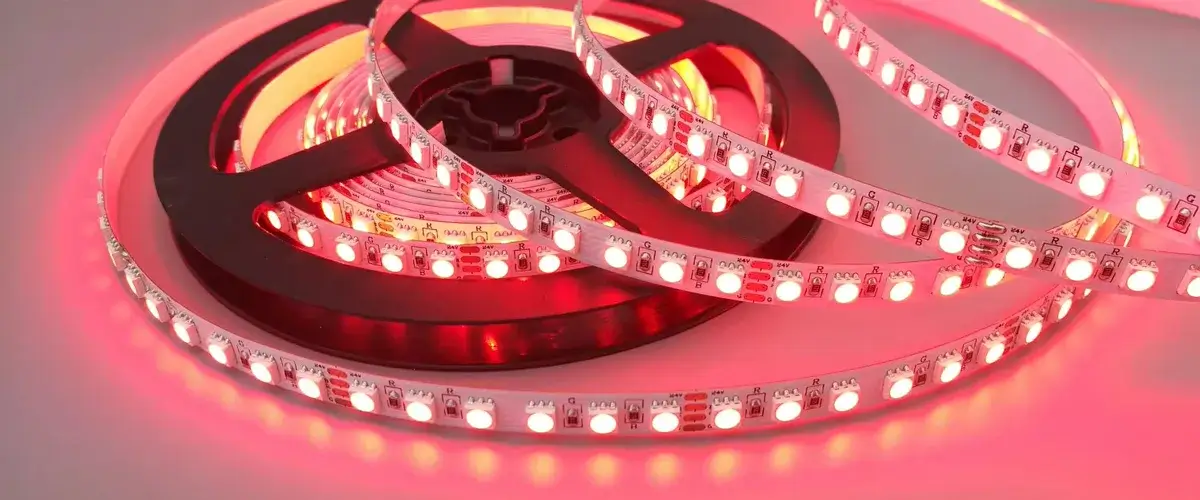
Chociaż moc znamionowa lamp LED jest ważną metryką, na rzeczywiste zużycie energii w rzeczywistych aplikacjach często wpływa kombinacja wielu czynników. Zrozumienie tych zmiennych może pomóc w dokładnej ocenie kosztów eksploatacji projektu i projektowania elektrycznego.
1. Gęstość LED (diody LED na metr)
Im więcej diod LED na metr, tym wyższe zużycie energii na metr i jaśniejsze światło.
| Gęstość diod LED | Wspólny zakres mocy | Scenariusze aplikacji |
| 30 diod LED/m | 4,8–7,2 W/m | Oświetlenie nastroju wnętrza szafki, miękkie oświetlenie |
| 60 diod LED/m | 9,6–14,4 W/m | Reklamowe skrzynki świetlne, podświetlenie okien |
| 120 diod LED/m | 18–24 W/m | Oświetlenie główne o wysokiej jasności, oświetlenie wyświetlacza |
2. Temperatura barwowa i typy kolorów
- Monochromatyczne paski świetlne (np. 3000K ciepłej bieli lub 6000K Cool White) generalnie mają niższe zużycie energii. (Chcesz dowiedzieć się więcej o różnicach między tymi temperaturami kolorów? Przeczytaj nasz wpis na blogu: 3000K vs 4000K vs 5000K vs 6000K: jaka jest różnica?)
- Paski świetlne RGB lub RGBW zazwyczaj zawierają wiele chipów, co skutkuje znacznie większą mocą na jednostkę długości; paski świetlne RGBW mogą nawet przekroczyć 20 W/m.
Dodatkowo, wydajność świetlna (LM/W) diod LED o różnych kolorach światła jest różna; na przykład chłodne białe światło zazwyczaj ma wyższą wydajność świetlną niż czerwone lub niebieskie światło.
3. Napięcie znamionowe: 12V vs. 24V vs. 48V
- Chociaż samo napięcie nie określa zużycia energii, bezpośrednio wpływa na rozmiar prądu i straty linii.
- Do okablowania powyżej 5 metrów lub zastosowań komercyjnych systemy 24 V lub 48V oferują korzyści, skutecznie zmniejszając spadek napięcia i poprawiając wydajność energetyczną.
4. Kontrola ściemniania i tryby pracy
kiedy Kontrolery ściemniania (takie jak ściemnianie PWM, ściemnianie 0-10V lub sterowanie DMX) paski LED nie zawsze działają przy jasności 100%, co skutkuje zmniejszonym średnim zużyciem energii.
Na przykład zmniejszenie jasności do 70% przy użyciu sterowania PWM powoduje odpowiednie zmniejszenie rzeczywistego zużycia energii o 30%.
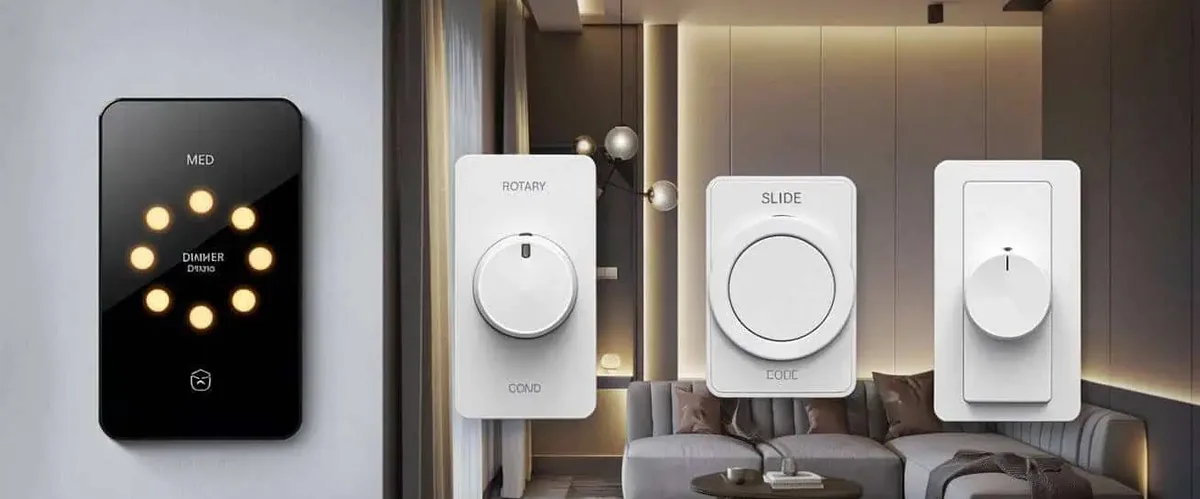
5. Środowisko pracy i warunki rozpraszania ciepła
Środowiska o wysokiej temperaturze lub słabe rozpraszanie ciepła może zmniejszyć wydajność świetlną i elektryczną chipów LED, co potencjalnie prowadzi do nieprawidłowego zużycia energii.
- W przypadku zainstalowania w zamkniętych kanałach aluminiowych, wnętrzach szafek lub zewnętrznych zamkniętych środowiskach zaleca się stosowanie Profile aluminiowe LED do optymalizacji rozpraszania ciepła.
- Na każde 10°C wzrost temperatury otoczenia, wydajność LED może zmniejszyć się o ponad 51 TP3T.
6. Czas trwania i częstotliwość użytkowania
- Komercyjne paski LED działające przez ponad 10 godzin dziennie będą skutkować znacznie wyższymi miesięcznymi kosztami energii elektrycznej w porównaniu do krótkoterminowych scenariuszy użytkowania w budynkach mieszkalnych.
- W przypadku scenariuszy operacyjnych 24/7 (takich jak sklepy ogólnospożywcze lub oznakowanie marki sieciowej), wybór modeli o wysokiej wydajności i niskich poziomach energii może znacznie obniżyć długoterminowe koszty energii elektrycznej.
Podsumowując, zużycie energii w taśmie LED to nie tylko nominalny parametr „W/M”, ale dynamiczna zmienna systemowa. Rozsądna ocena tych czynników może pomóc w kontrolowaniu ryzyka związanego z zużyciem energii i presji budżetowej od momentu powstania projektu.
Porównanie zużycia energii różnych typów lamp LED taśmowych
W rzeczywistych projektach wybór lampek LED często wiąże się z równoważeniem jasności, zużycia energii i wydajności. Lampy taśmowe LED o różnych specyfikacjach opakowań, metody oświetlenia i zastosowania funkcjonalne wykazują znaczne różnice w zużyciu energii na jednostkę. Poniżej znajduje się typowe porównanie zużycia energii kilku typów głównych typów lamp LED.
Wspólne parametry zużycia energii LED w skrócie
| Typ paska świetlnego | Napięcie | Gęstość diod LED | Moc | Wydajność świetlna (lm/w) | Scenariusze zastosowań |
| 3528 Mono Pasek świetlny | DC12V/24V | 60 diod LED/m | 4,8 W/m | 80–100 | Oświetlenie otoczenia, podświetlenie domu |
| Pasek świetlny 5050 RGB | DC12V/24V | 60 diod LED/m | 14,4 W/m | 60–75 | Dynamiczna dekoracja, wielokolorowa kontrola |
| Pasek LED o wysokiej jasności 2835 | Prąd stały 24 V | 120 diod LED/m | 19,2 W/m | 100–120 | Oświetlenie komercyjne, główne źródło światła detalicznego |
| Taśma LED COB | Prąd stały 24 V | 480 diod LED/m | 11W/m | 100–110 | Brak aplikacji do strefy ciemnej, podświetlenie okien |
| Pasek LED RGBW 4 w 1 | Prąd stały 24 V | 60 diod LED/m | 18–20W/m | 50–65 | Oświetlenie konturowe na zewnątrz, wielokolorowe oświetlenie sceny |
Zalecenia dotyczące wyboru (w oparciu o wymagania projektowe):
- Skupienie na efektywności energetycznej → Wybierz lampki LED o skuteczności świetlnej przekraczającej 100 lm/W lub monochromatyczne lub Taśmy LED COB.
- Wymagaj wielokolorowych efektów dynamicznych → Rozważ cyfrowe adresowalne lampki LED RGB lub RGBW, ale zwróć uwagę na zwiększone całkowite zużycie energii.
- Poszukiwanie jednolitej wydajności świetlnej i odrzucanie oświetlenia punktowego → paski oświetleniowe LED COB to idealny wybór.
- Dla długodystansowego oświetlenia liniowego → priorytet 24 V lub 48 V długofalowe paski świetlne LED w celu zmniejszenia spadku napięcia.
Dzięki tym porównaniom możesz bardziej intuicyjnie wybrać paski świetlne LED, które równoważą wydajność i zużycie energii, unikając takich problemów, jak nadmierna specyfikacja, szybki zanik światła lub wysokie koszty energii elektrycznej. Aby uzyskać więcej informacji na temat wyboru i zakupu lampek LED, przeczytaj na blogu: Kompletny przewodnik po zakupie taśm LED.
Energooszczędne zalecenia optymalizacji dla zastosowań komercyjnych
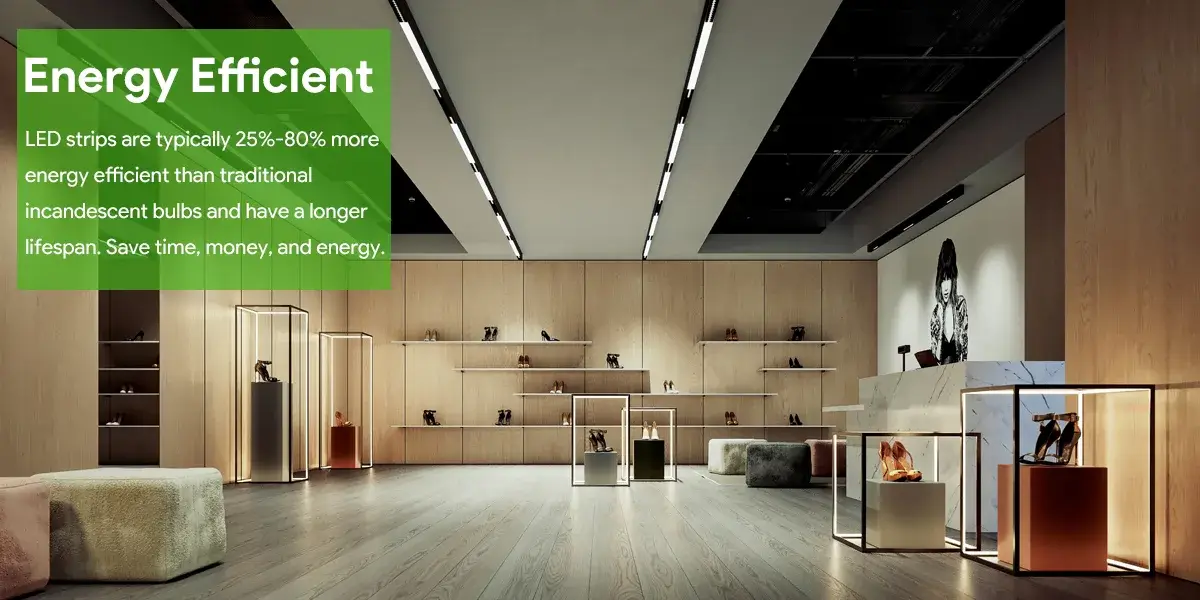
W komercyjnych i przemysłowych zastosowaniach oświetleniowych listwy oświetleniowe LED często działają przez długi czas, wymagają złożonego okablowania i są używane w różnych środowiskach. Nawet drobne błędy w konfiguracji mogą skutkować stratami energii lub skróceniem żywotności. Poniżej przedstawiono kilka sprawdzonych strategii oszczędzania energii, które mogą pomóc w osiągnięciu wyższej efektywności energetycznej oraz niższych kosztów eksploatacji i konserwacji w swoich projektach.
1. Priorytet traktuj produkty o wysokiej wydajności, wysokiej jakości (≥100 lm/W).
Wyższa skuteczność świetlna oznacza niższe zużycie energii dla tej samej jasności. Na przykład listwa świetlna 100 lm/W wymaga tylko 10 W, aby uzyskać 1000 lumenów, podczas gdy listwa świetlna o mocy 80 lm/W może wymagać 12,5 W, co skutkuje znaczną różnicą w stosunku do wydłużonej pracy.
Wskazówka: priorytetem wykorzystywania Pasek LED o wysokiej jasności 2835 lub pasek LED COB, który zapewnia doskonałą skuteczność świetlną i lepsze rozpraszanie ciepła.
2. Rozsądnie zaplanuj długość taśmy LED, aby uniknąć nadmiernych spekulacji lub marnotrawstwa.
- Oblicz moc na podstawie rzeczywistej długości, aby uniknąć „nadmiernej rezerwacji”, co prowadzi do nadmiernego zużycia energii.
- W przypadku konstrukcji liniowych lub projektów oświetlenia konturowego zaleca się precyzyjne pomiary wymaganej długości na podstawie rysunków CAD.
Wskazówka: Nadmiar taśm LED można wbudować w systemy sterowania strefowego lub przyciąć na zamówienie w celu zmniejszenia zbędnego zużycia energii.
3. Zoptymalizuj zasilanie i strukturę okablowania, aby zminimalizować straty spadku napięcia.
- selekcjonować Wysokowydajne zasilacze o stałym napięciu (Wydajność konwersji ≥ 90%) Kompatybilny z paskami LED.
- Użyj wystarczająco grubych miedzianych przewodów, aby zapobiec Spadek napięcia oraz zwiększone zużycie energii spowodowane transmisją na duże odległości.
- W przypadku projektów z odległościami okablowania przekraczającymi 10 metrów zaleca się stosowanie systemu DC24V lub DC48V.
Przykład: W 15-metrowej konfiguracji okablowania system DC12V może odczuwać nierówną jasność z powodu spadku napięcia, podczas gdy system DC24V może skutecznie rozwiązać ten problem.
4. Wdrażaj ściemnianie/inteligentne systemy sterowania.
Przyciemnianie nie tylko poprawia atmosferę i wrażenia wizualne, ale także bezpośrednio zmniejsza zużycie energii. Typowe metody kontroli to np.
- Przyciemnianie PWM (odpowiednie do systemów atmosferycznych/oświetlenia toru)
- Przyciemnianie 0–10 V (nadaje się do komercyjnego oświetlenia biurowego)
- Kontrola DMX (odpowiednia dla projektów dynamicznych RGB)
- Timer + kontrola czujnika (odpowiednie do przestrzeni publicznych, hal wystawowych itp.)
Przyciemnianie danych odnośnika: Po przyciemnieniu do jasności 70%, rzeczywisty pobór mocy można zmniejszyć o około 30%.
5. Połącz z profilami aluminiowymi lub podłożami przewodzącymi ciepło, aby zwiększyć wydajność rozpraszania ciepła.
Efektywne rozpraszanie ciepła nie tylko wydłuża żywotność taśmy LED, ale także poprawia wydajność obwodu i zmniejsza straty mocy. Zalecane kombinacje:
- Profile aluminiowe w kształcie litery U/wstawione + osłony dyfuzora
- W przypadku instalacji na zewnątrz użyj wodoodpornych kanałów aluminiowych i zapewnij odpowiednią konstrukcję przepływu powietrza.
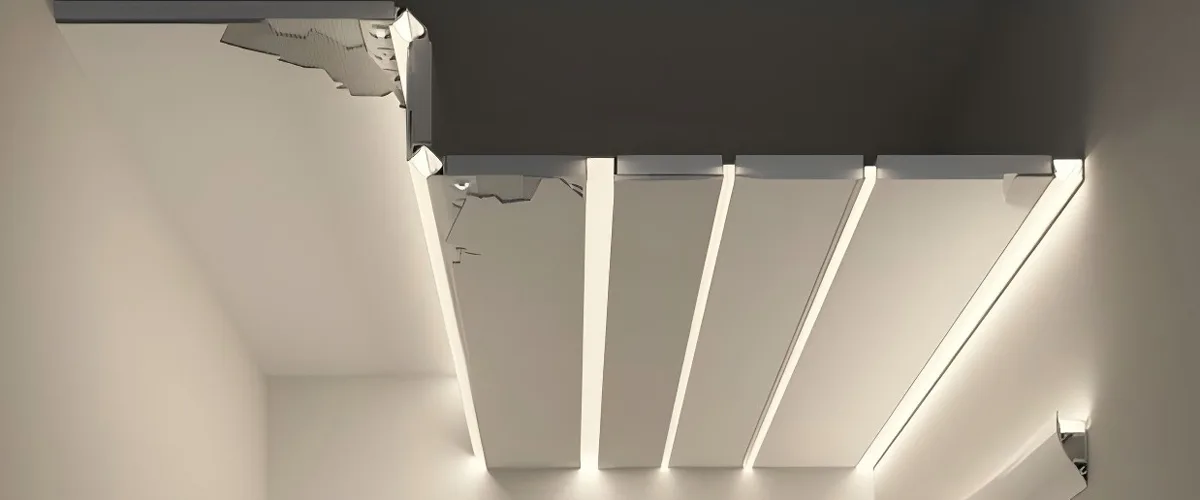
6. Wykonaj regularne konserwacje.
Z czasem na listkach oświetleniowych LED może gromadzić się kurz i brud, zmniejszając ich jasność i wydajność. Regularne czyszczenie zapewnia optymalną wydajność. Dodatkowo regularnie sprawdzaj połączenia i źródła zasilania, aby upewnić się, że działają prawidłowo.
Wdrażając powyższe strategie, możesz nie tylko zmniejszyć ogólne koszty energii elektrycznej, ale także zwiększyć stabilność i żywotność całego systemu oświetlenia taśmy LED, minimalizując w ten sposób częstotliwość i przydział budżetu na przyszłą konserwację.
Przykłady obliczeń aplikacji i obliczeń zużycia energii w świecie rzeczywistym
Aby uzyskać bardziej intuicyjne zrozumienie wydajności zużycia energii taśm oświetleniowych LED, wykorzystujemy trzy popularne komercyjne scenariusze oświetlenia jako przykłady do przeprowadzania szczegółowych oszacowań zużycia energii elektrycznej i kosztów energii elektrycznej oraz porównania ich z rozwiązaniami energooszczędnymi.
Przypadek 1: Oświetlenie okienne sklepu odzieżowego (przy użyciu pasków świetlnych Mono Cob)
Specyfikacje paska świetlnego: Pasek świetlny 24V COB, 14W/m, skuteczność świetlna 100 lm/W
Długość instalacji: 10 metrów
Średni dzienny czas pracy: 10 godzin
Cykl pracy: 30 dni/miesiąc
Odniesienie do stawki za energię elektry $0.12/kWh

Obliczenie zużycia energii:
Moc całkowita = 14 W × 10 metrów = 140 W
Dzienne zużycie energii elektrycznej = 140 W × 10 godzin ÷ 1000 = 1,4 kWh
Miesięczne zużycie energii elektrycznej = 1,4 × 30 = 42 kWh
Miesięczny koszt energii elektrycznej = 42 × $0.12 = $5.04
Roczny koszt energii elektrycznej = $5,04 × 12 = $60.48
Optymalizacja energooszczędna:
Jeśli Taśma LED o wysokiej jasności 2835 Przy wyższa skuteczność świetlna (np. 190 lm/W) zużycie energii wynosi tylko 12 W/m, co zmniejsza miesięczny rachunek za energię elektryczną do $4,32 i oszczędza ponad $8,64 na urządzenie rocznie.
Przypadek 2: Oświetlenie konturowe korytarza handlowego (przy użyciu taśm LED RGB)
Specyfikacje taśmy LED: Taśma LED RGB 24V RGB, 14,4 W/m
Długość instalacji: 30 metrów
Średni dzienny czas użytkowania: 12 godzin (automatyczna kontrola czasowa)
Cykl pracy: całoroczny
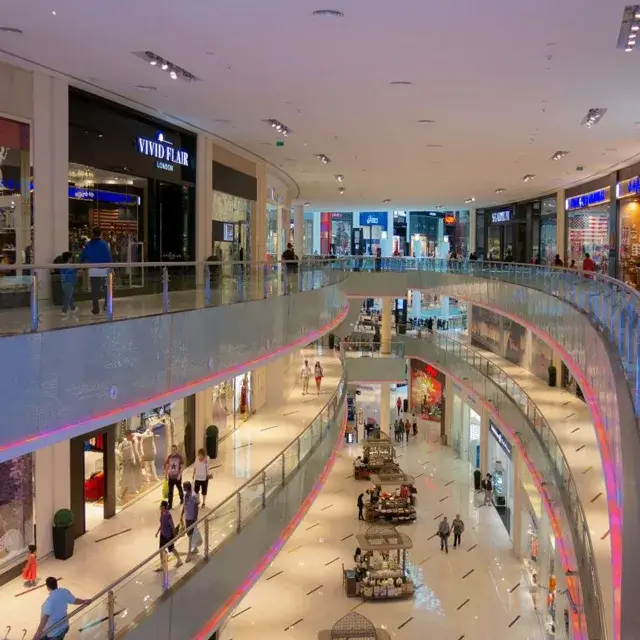
Obliczenie zużycia energii:
Moc całkowita = 14,4 W × 30 metrów = 432 W
Dzienne zużycie energii elektrycznej = 432 × 12 ÷ 1000 = 5,18 kWh
Roczne zużycie energii elektrycznej = 5,18 × 365 ≈ 1 891,7 kWh
Roczny koszt energii elektrycznej ≈ $227.00
Optymalizacja energooszczędna:
Wprowadzając sterowanie ściemnianiem DMX, ze średnią jasnością 70% w oparciu o rzeczywistą pracę, całkowite zużycie energii zmniejsza się do 302 W, a roczny koszt energii elektrycznej spada do około $158.70, oszczędzając $68+/rok/lokalizację.
Przypadek 3: Oświetlenie sufitowe biurowe (wbudowane liniowe paski świetlne)
Specyfikacje paska świetlnego: 24V Wysoka jasność 2835 Pasek świetlny, 18W/m, CRI > 90
Całkowita długość instalacji: 50 metrów
Czas użycia: 8 godzin dziennie, działa w dni powszednie (22 dni w miesiącu)
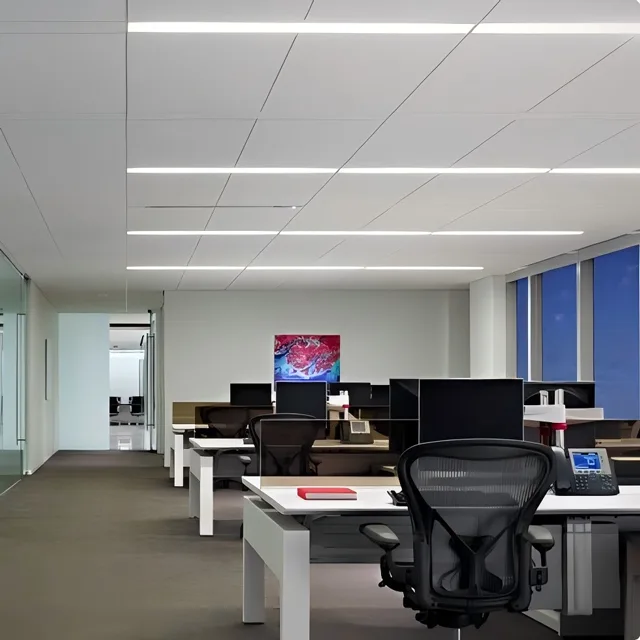
Obliczenie zużycia energii:
Moc całkowita = 18 × 50 = 900 W
Miesięczne zużycie energii elektrycznej = 900 × 8 × 22 ÷ 1000 = 158,4 kWh
Miesięczny koszt energii elektrycznej = 158,4 × $0,12 = $19.01
Roczny koszt energii elektrycznej = $19,01 × 12 = $228.12
Optymalizacja energooszczędna:
- Optymalizuj do wyższą wydajność pasa świetlnego COB 130 lm/W, wymagając tylko 8 W na metr → roczne oszczędności kosztów energii elektrycznej w wysokości około $120+.
- Zainstaluj system ściemniania 0-10 V, aby dostosować jasność w oparciu o naturalne światło, oferując większy potencjał energooszczędny.
Podsumowanie:
| arena | Pierwotny roczny koszt energii elektrycznej | Roczny koszt energii elektrycznej po optymalizacji energooszczędnej | Roczne oszczędności kosztów energii elektrycznej |
| oświetlenie okien | $60.48 | $51.84 | $8.64 |
| Oświetlenie konturu centrum handlowe | $227.00 | $158.70 | $68.30 |
| Oświetlenie głównego biura | $228.12 | $101.37 (szacowany) | $126.75 |
W przypadku projektów o średniej lub dużej skali nawet 2 W oszczędności energii na metr mogą skutkować znaczną optymalizacją kosztów operacyjnych po zakumulowaniu.
FAQ
W porównaniu z tradycyjnym oświetleniem, listwy świetlne LED mają już bardzo niskie zużycie energii. Przy przykładzie paska świetlnego LED 12W/m o długości 10 metrów, nawet jeśli jest włączona przez 24 godziny na dobę, dzienne zużycie energii elektrycznej wynosi tylko 2,88 kWh. Przy stawce za energię elektryczną $0.12/kWh dzienny koszt energii elektrycznej wynosi około $0,35. Jednakże, jeśli duża liczba pasków jest rozmieszczana i utrzymywana przez dłuższy czas, nadal zaleca się stosowanie kontroli czasu lub ściemniania w celu dalszego zmniejszenia zużycia energii.
Teoretycznie przy tej samej mocy znamionowej (np. 14,4 W/m) zużycie energii pasków LED 12V i 24V jest takie samo. Jednakże, ponieważ system 12V ma wyższy prąd, jest bardziej podatny na spadek napięcia i straty ciepła podczas okablowania na duże odległości, zmniejszając w ten sposób wydajność i zwiększając zużycie energii. W przypadku zastosowań powyżej 5 metrów lub do użytku komercyjnego zaleca się stosowanie systemu 24V lub 48V.
Tak. Każdy moduł LED w pasku LED RGB zawiera zazwyczaj trzy kolorowe chipy (czerwony, zielony i niebieski), co skutkuje wyższym zużyciem energii. Paski LED RGBW zawierają również dodatkowy układ świetlny z białym światłem, z poborem mocy potencjalnie sięgającym 18–20 W/m. Monochromatyczne paski LED zazwyczaj mają moc znamionową między 4,8 a 12 W/m. Jeśli efektywność energetyczna jest priorytetowa, należy racjonalnie zaplanować obszary użytkowania RGB.
Tak. Zaleca się użycie miernika mocy zamontowanego na gniazdo lub miernika mocy przy źródłach z odczytami kilowatogodzin (kWh) do bezpośredniego pomiaru mocy w czasie rzeczywistym, skumulowanego zużycia energii elektrycznej i szacowanych kosztów energii elektrycznej w całym systemie. Jest to bardzo odpowiednie do testów na miejscu i oceny efektywności energetycznej.
Tak, szczególnie w przypadku metod ściemniania, takich jak PWM, 0-10V, DALI i DMX. Gdy jasność jest zmniejszona, prąd zmniejsza się synchronicznie, a zużycie energii również zmniejsza się. Na przykład ustawienie jasności paska świetlnego na 70% zmniejsza zużycie energii o około 301 TP3T. Wydłuża również żywotność opraw oświetleniowych i zmniejsza częstotliwość konserwacji.
Wniosek: dlaczego wybrać wysokowydajne lampki LED Signliteled?
Na dzisiejszym rynku oświetleniowym, który stawia na priorytet efektywności energetycznej i ochronie środowiska, ochrona energii jest nie tylko trendem, ale także kluczową gwarancją kontroli budżetu projektu i długoterminowych zwrotów. W tym artykule szczegółowo przeanalizowaliśmy czynniki wpływające na zużycie energii światła w taśmie LED i strategie optymalizacji oszczędzania energii, od podstawowych obliczeń po rzeczywiste studia przypadków.
SignLited zobowiązuje się do dostarczania klientom:
- Wysokowydajne rozwiązania oświetleniowe LED (100-200 lm/W) w celu zmniejszenia zużycia energii na metr
- Precyzyjne usługi dopasowywania mocy i projektowania zasilania, aby zapobiec przeciążeniu i marnotrawstwu
- Kompatybilność z inteligentnym sterowaniem zapewnia łatwe ściemnianie i oszczędność energii w strefie
- Wsparcie dostosowania specyficzne dla projektu Aby sprostać równowadze między skutecznością świetlną a zużyciem energii w różnych scenariuszach
Jeśli szukasz Taśmy LED W tej równowadze jasności, żywotności i efektywności energetycznej, skontaktuj się z nami, aby poprosić o próbki testowe lub wsparcie techniczne indywidualne.
